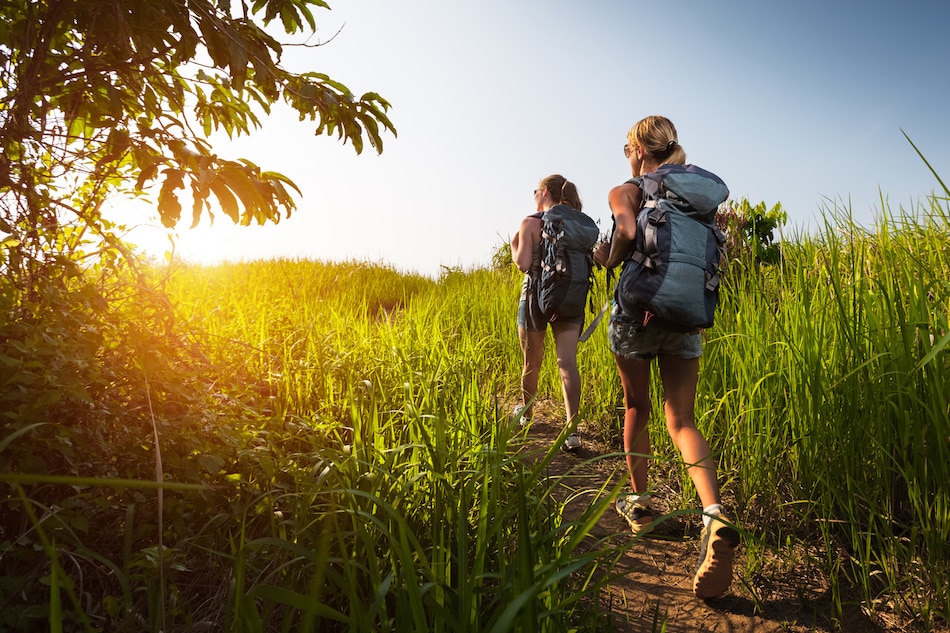Hiking is a great way to explore the outdoors, stay in shape, and test your physical abilities (but not quite as much as if you were caving). Plus, hiking is a great activity while camping with kids, and you can even take your dog. At the same time, every hike is different. If you’re new to hiking in the great outdoors, there’s a lot to consider about what to bring, what to do when you encounter other hikers, and so on. Here’s a crash course in everything a beginner hiker should know before hitting the trails.
What We'll Cover
- The Basics of Hiking
- How to Choose a Hiking Trail
- How Much Time You Have
- Your Fitness Level
- The Distance of the Hike
- Elevation Gain
- Time of Year and Weather
- Calculating Hike Difficulty
- Trail Etiquette
- The Ten Essentials of Hiking
- Navigation Items
- Sun Protection
- Insulation
- Illumination
- First Aid
- Fire
- Gear Repair Kits
- Nutrition
- Hydration
- Emergency Shelter
- Hiking Safety Essentials
- Conclusion
The Basics of Hiking
When it comes to hiking, there are a few basics to keep in mind. The three basic things to know about hiking are how to choose a trail, what you should bring with you, and how to share the trails with others. If you know the answers to these three things, you can hike just about anywhere.
How to Choose a Hiking Trail
When trying to find the right hiking trail, there are several factors to consider. These include:
How Much Time You Have
Think about how much time you have for the hike. Some people take large packs on their backs and hike for several days at a time, and other people might only plan on hiking for a few hours. No matter how much time you have available, there is an appropriate hike out there. Make sure you choose a trail that fits your schedule.
Your Fitness Level
When people think about sports, they likely think about swimming, basketball, baseball, football, soccer, and more. While hiking might not fall under the category of your “traditional” sport, this is still physically demanding. Some hikes can last for dozens of miles and witness thousands of feet in elevation changes, and someone who isn’t physically prepared won’t be able to finish it. Make sure you are physically ready for the trail ahead.
The Distance of the Hike
Of course, it is also important to think about the distance of the hike. Distance is going to be the main factor in figuring out how long the hike is going to take. Some hikes might travel in a loop for a couple of miles, and some hikes might have numerous branch points that can significantly influence its distance. Think about how far the hike is going to go.
Elevation Gain
Elevation changes are going to play a major role in how hard the hike is going to be. Some hikes might have thousands of feet in elevation change that will make it exceptionally difficult. In addition to thinking about the cumulative elevation change, also judge how quickly the elevation is going to change. The faster the elevation changes, the harder the hike is going to be.
Time of Year and Weather
Lastly, also think about the time of year and weather. This is going to play a major role in how hard the hike is going to be. For example, in the middle of the summer, the heat and humidity will make dehydration a major factor. In the winter, snow and ice might be present on the trail, adding to its difficulty. In addition, consider the weather. Driving snow, pouring rain, and howling winds all have the potential to make a hike more difficult.
Be sure to think about these factors when deciding on a trail. In addition, think about the difficulty of the hike as well.
Calculating Hike Difficulty
Many national parks have pre-determined ratings for their hiking trails listed. There two scales on which a hike’s difficulty can be measured: The 1-5 scale and the 1-200 scale. In both scales, a rating of 1 means the hike is easy, and the higher the number, the more the difficulty increases.
If a trail doesn’t have an official rating but you can find other information about it, you can also calculate the difficulty yourself by using the following formula:
Take the elevation gain of the hike, multiply this by two, and multiply this result by the distance of the hike in miles. Finally, take the square root of this result.
The answer is the difficulty of the hike. Like with the previous two scales, the higher the resulting number, the more difficulty the hike.
Trail Etiquette
When on the trail, there are a few important points to remember when it comes to manners. This will go a long way toward making sure everyone shares the trail appropriately.
The Right of Way
There are a few rules to remember about the right of way on the trail. In general, the individual with the greater degree of maneuverability is expected to yield to the other party. These rules include:
Hikers Passing Other Hikers
If you aren’t familiar with hiking, it might seem that hikers would never get in each one another’s ways, but there are narrow trails out there. The rule of thumb is that hikers that are traveling uphill always have the right of way. It is more exhausting to walk uphill and hikers may be in a certain rhythm that they would rather not break. Therefore, yield to any hiker who is moving uphill. If you are passing someone from behind, be sure to call out and let him or her know that you are coming. A simple extension of courtesy can go a long way on the hiking trail.
Hikers and Bikers
Mountain bikers are considered to have a greater degree of maneuverability when compared to hikers (specifically, their legs). Therefore, bikers are expected to yield to hikers in most situations. While these are the rules, bikers also tend to be moving more quickly than hikers. As a result, in most situations, bikers will not be able to maneuver quickly enough. Therefore, when possible, hikers should try to get out of the way of bikes; however, hikers do technically have the right of way. Bikers are expected to call out if they are going around switchbacks or coming down slopes at a high rate of speed.
Hikers and Horses
Horses are typically the slowest users of the trail (even though they can travel much quicker when needed). Therefore, horses are expected to have the right of way over both hikers and mountain bikes. If there are any horses spotted on the trail, they should be given a wide berth. Furthermore, even though horses are enticing to pet, leave them alone. Horses are skittish, and if one feels something touch it, it could spook, which can create a chain reaction with any other horses that may be with it.
Leave No Trace
One of the cardinal rules about hiking is called Leave No Trace. Those who spent time in Boy Scouts or Girl Scouts have undoubtedly heard this rule before. The theme behind this rule is that people are merely visitors on the trail. For plants and animals, this is their home. Therefore, it is important for us to leave the trail as we found it, or better. Try not to disturb any wildlife during the hike, and make sure you don’t leave any garbage behind. Furthermore, if any garbage is present on the trail, pick it up and dispose of it properly when you get back to camp. It is important for everyone on the trail to work together to make sure all hiking trails are kept just as clean as they were found.
The Ten Essentials of Hiking
When someone goes on a hike, it is important to bring all the necessary equipment. The ten essentials of hiking include:
Navigation Items
This includes a hiking compass or GPS. Also, consider bringing a map. While this might sound a little bit old-school, this is an important tool as it often has key landmarks on it that can help someone avoid getting lost. Furthermore, with a map and a compass, hikers can orient the map, helping them figure out which direction they are traveling. If you bring a map, make sure you brush up on how to read it. A hiking GPS is a good piece of equipment to have, but it might rely on a satellite connection that could be hard to find.
Sun Protection
Remember to bring sunscreen, SPF lip balm, SPF clothing, and hats. Even though the temperature might feel a bit cool outside, the sun is still shining, so UV protection is still necessary. You can never have too much sunscreen, so make sure you have enough for everyone and remember to apply it every few hours. Getting sunburns while hiking can make a physically demanding activity that much more difficult.
Insulation
Particularly important during the winter, be sure to bring gloves, a jacket, and thick socks. It is always better to have too many layers and take one off than to be missing a layer when it is needed. The dead of winter can be particularly gruesome on exposed surfaces. Heating packs, gloves, and thermal undergarments can prevent frostbite from developing. Always make sure to have plenty of insulation when camping in cold weather.
Illumination
When you’re camping, you need to have your own source of light. Make sure to bring headlamps, flashlights, or a lantern. Illumination isn’t just necessary at nighttime, but also if the sun goes behind the clouds or if it starts to pour rain outside. Light is necessary to light up hazards that might be present on the hiking trail. This might include sharp objects, poison ivy, or dangerous animals. Furthermore, lights are an important signal to other hikers that you and your part are present on the trail.
First Aid
Injuries can happen at any time, so make sure to bring survival kits or a camping first aid kit. There are a few important items that everyone should keep in their first aid kit. For example, try to have bandages of varying sizes along with gauze and alcohol wipes to clean potential wound sites. In addition, it is a good idea to include an ace bandage and something sturdy to be used as a splint. Finally, Neosporin or something similar can be used to prevent infections from developing following a serious laceration.
Fire
In some situations, a fire might be necessary. Firestarters can be helpful—they can take the form of lighter fluid, a flint, and even a set of matches. For those who are hiking for multiple days, fires are important for not only staying warm but also for cooking food at the campsite. Finally, fires can also be used to signal others in the event of an emergency.
Gear Repair Kits
Equipment can break down or rip, so it’s a good idea to have a gear repair kit on hand. There are a few items that should be included in this kit. First, always have duct tape because it can fulfill a number of different roles and is incredibly versatile. Next, have a knife or a multi-tool of some sort that can be used to accomplish a variety of tasks. A nylon utility cord can also be helpful for tying down various items. If you want to be prepared for your clothes ripping, you can also have a pocket sewing kit on hand.
Nutrition
Think about nutrition during the hike. In general, carbohydrates and protein are both important because they both do the most to fuel you and provide you with energy. Some of the great foods to bring on hikes include protein bars, granola bars, trail mix, and other light, calorie-dense foods. Those who are hiking for multiple days should plan on having a way to prepare full meals.
Hydration
Proper hydration is going to be essential for every hike, so you should consider bringing camping water filters, water purifiers, hydration packs, and water bottles. You may be surprised at how much water and sports drinks might weigh. Stocking up on water bottles will weigh down the party quickly, so water purifiers are great for finding liquid hydration along the trail. Furthermore, it is also a good idea to have powdered sports packets to add to water once it has been collected. This is a great source of electrolytes, which are extremely helpful if you get dehydrated.
Emergency Shelter
The elements may force you to seek shelter before you’re ready, and fortunately, there are a few forms of emergency shelter. Some people may elect to make camp with nothing but a tarp and a few poles, and other people may prefer to have a tent. Remember that the emergency shelter is going to have to be carried with the party, so it needs to be lightweight and easy to set up.
Hiking Safety Essentials
While many of the items on this list should be considered safety essentials when it comes to hiking, there are a few other tips to keep in mind. First, try to avoid hiking in the middle of the night. When it is pitch black outside, it is nearly impossible to see potential hazards on the trail. These hazards might include exposed rocks, roots, and even dangerous animals. A flashlight or headlamp can only do so much.
Next, while some people may like to embrace the challenge of hiking in adverse weather, remember how much more dangerous this is. Driving rainstorms can quickly flood hiking paths, and snow and ice can create an avalanche situation. Even high winds can make hiking around cliffs and ledges unsafe. Try to stay away from adverse weather.
Finally, always tell someone where you’re going or use the buddy system. There are plenty of stories about missing hikers, and in these situations, authorities need to have a location to start their search. Always tell a family member or friend where you are hiking, or better yet, take someone with you.
Conclusion
These are a few of the most important points that everyone needs to remember when they go on a hike or backpacking trip. With this guide, everyone will be able to find the right trail for them, take care of the trail during the hike, and be prepared for whatever nature throws their way. Now, go out and explore the beauty of the outdoors and all this world has to offer!
The responses below are not provided, commissioned, reviewed, approved, or otherwise endorsed by any financial entity or advertiser. It is not the advertiser’s responsibility to ensure all posts and/or questions are answered.


![Tips to Go Camping With a Toddler [Different Weather]](/assets/images/375a17532f44c72a41d33b1008823cf3.png)


